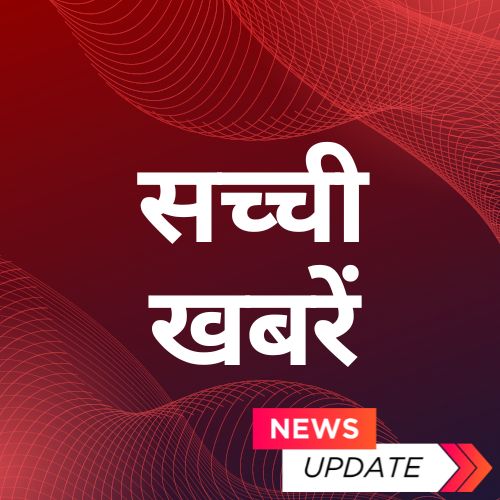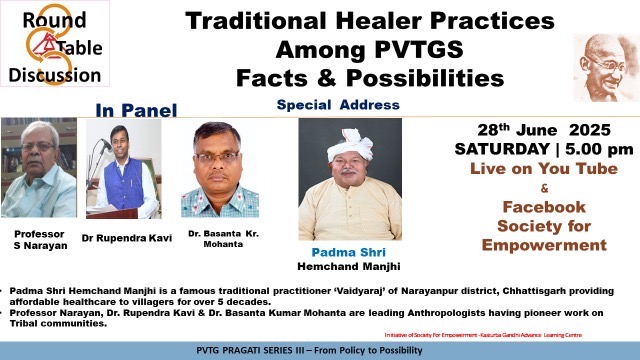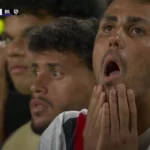
@ Vikash Sharma | Sr Journalist
The Society for Empowerment, in its continued commitment to inclusive and culturally-rooted tribal development, organized a focused online discussion on “Traditional Healer Practices Among PVTGs: Facts & Possibilities” on 28th June 2025. This policy dialogue aimed to explore participatory and context-specific approaches for the holistic well-being of Particularly Vulnerable Tribal Groups (PVTGs), with special reference to the indigenous healing traditions preserved across Chhattisgarh, Odisha, Jharkhand, and Bihar.
The session was inaugurated by Padma Shri Hemchand Manjhi, a renowned traditional healer and Vaidyaraj from Narayanpur district, Chhattisgarh, who has dedicated over five decades to providing affordable and indigenous healthcare to forest-dwelling tribal communities. The discussion was enriched by the presence of leading anthropologists—Professor Narayan, Dr. Rupendra Kavi and Dr. Basant Kumar Mohanta—whose pioneering work in tribal ethnography and health systems provided critical insights into the challenges and potential of integrating traditional wisdom into mainstream discourse.
The event was expertly moderated by Dr. Rupendra Kavi, anthropologist and currently the Deputy Director, Tribal Research Institute, Government of Chhattisgarh, who also delivered an insightful expert address.
The deliberation spotlighted the rich healing traditions of PVTGs, highlighting how ancient knowledge—largely transmitted orally—is ecosystem-specific, deeply spiritual, and interwoven with community life. Traditional healers such as Baiga, Ojha, Gunia, Pahaan, and Dehuri employ herbs, rituals, and natural techniques to address both physical and spiritual ailments. Among widely used herbs are Kadam (used by the Baiga in Chhattisgarh for treating fever and skin infections), Satavari (used by Kondh and Juang tribes in Odisha for reproductive health), Brahmi (used by the Paharia in Jharkhand and Bihar for memory and epilepsy), Giloy (a multipurpose immunity booster used by the Asur and Birhor tribes), and Neem, which is common to almost all PVTGs for skin and dental conditions.
Various traditional healing methods were discussed, including Herbal Pastes (Lepa) made from crushed leaves and roots; Decoctions (Kadha) using Giloy, Tulsi, and Black Pepper for fever; Fermented plant tonics utilized by tribes like the Asur; and occasional use of animal derivatives like snake skin, cow dung, or honey in special cases.
Professor S Narayan said that Illnesses are often interpreted by these communities as a breakdown of harmony with nature or ancestral spirits, and healing is seen as a collective spiritual process involving storytelling, singing, rituals, and the wisdom of elders. Speakers observed that this holistic and stress-relieving approach holds growing relevance for the high-pressure lifestyle of urban populations.
The discussion proposed several strategic possibilities to revive and integrate these healing traditions. These included the development of community herbal gardens to reduce reliance on forest gathering, the initiation of Healer Exchange Programs among PVTGs across states to promote cross-learning and revive disappearing practices, and the formal recognition of traditional healers under AYUSH systems as “Folk Doctors.” Participants also advocated for the creation of digital ethno-medicine libraries to document oral healing knowledge in audio-visual formats for future generations. Emphasis was placed on launching pilot programs, supported by the Ministry of Tribal Affairs and Ministry of AYUSH, to institutionalize healer gatherings, enable inter-state learning, and link certified traditional healers with public health outreach.
Highlighting government support for such initiatives, Professor S Narayan, said that “Inspired by the Hon’ble Prime Minister’s vision, the society, is committed to preserving and promoting traditional medicinal knowledge for the well-being of our communities.”
The Society for Empowerment concluded the session by reaffirming its dedication to cultural dignity, indigenous knowledge systems, and the empowerment of tribal communities through respectful integration of their age-old healing wisdom into contemporary health and policy frameworks.





